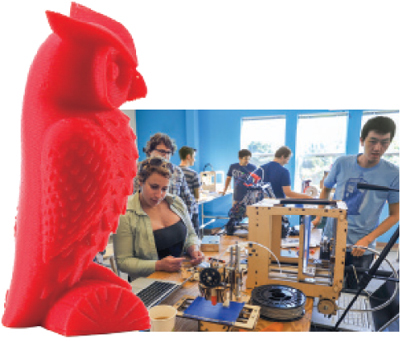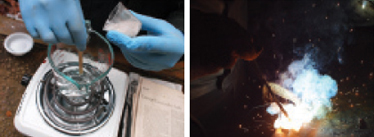READER INPUT
3D shootout, upcycling visions, pure Pyrex, and unholy smoking.

» Excellent job on your MAKE Ultimate Guide to 3D Printing (makezine.com/3dprinting). I’m thinking about buying or building a 3D printer with my grandson, so I read the issue looking for insight into what makes a good one.
One article advises to put the printer on a solid table; another talks about moving the extruder off the hot end to reduce mass. Both indicate that a lack of stiffness is a big problem in the design of a 3D printer. Combine this with drives that have substantial backlash and bearing systems that are relatively loose, and it’s easy to see why only one printer reproduced the hole in the bird’s beak.
This reminded me of a packaging machine I worked on years ago. It had a reciprocating carriage, and when we mounted a barcode printer on the machine, the printing smeared badly due to vibration. I set up a dial indicator with its probe touching the printer housing, and we found that one part of the mount deflected far more than the rest. We reinforced that part and the printer worked perfectly.
I suspect a little time with a dial indicator would be a real eye-opener for these 3D printer builders. MAKE could do technical reviews too, on the pros and cons of construction methods and how they affect the outcome.
—Gary H. Lucas, Hightstown, N.J.
» Your 3D printer “shootout” really helped set the standard and challenged us to do better for our users. We loved that you got together such a great team of testers, and that they were able to generate so much useful input in such a short time. We’re working hard to do better at the “Christmas morning test.” The “torture test” prints have also challenged the community: expect to see many more printers achieving top results on that one!
Community standards are fundamental — there is so much interest, and so many wonderful new printers, that developing a common language and set of metrics will really be important for users now and in the future. We have several thoughts on how to develop even more accurate and objective testing procedures. We really hope you will consider making this a regular issue. We believe your continued active role will be crucial to ensuring a collaborative and open 3D printing community in the future.
—Espen Sivertsen and the Type A Machines team, San Francisco

» I really enjoyed Chris Hackett’s “DIY Welding Rod” project (Volume 33), but I noticed the NaOH (and HCl) chemistry was done in a Pyrex measuring cup. When World Kitchens bought the rights to make Pyrex cookware in the United States, they switched the recipe from borosilicate (true Pyrex) to tempered soda-lime glass (like car window glass). Tempered glass is strong and heat resistant, but scratches will significantly weaken it, and when it breaks it shatters into little cubes. People have cooked with it for years and most have no problems, but I suggest splurging on real Pyrex labware to heat acids and bases at home.
—Josh Feldman, Lawrence, Kan.
» I enjoyed your DIY meat smoker project (“Nellie Bly Smoker,” Volume 32). I realize it uses an electric element as a heat source, but if readers do experiment with adding charcoal as you suggest, regular charcoal briquettes should never be used, as they contain anthracite coal and will impart a less-than-desirable flavor. Natural lump charcoal made from hickory, mesquite, etc., will keep the smoke flavor pure and temperature consistent.
—Brent Benson, Corona, Calif.
PROJECTS EDITOR KEITH HAMMOND REPLIES:
Brent, you’re right, we should’ve cautioned against fossil-fuel-fortified briquettes; veteran BBQers consider them sacrilege. When testing the Nellie Bly Smoker, I experimented with natural mesquite lump charcoal to raise the temperature on a big batch of beef brisket. It worked. And tasted great.

» The 3D printing movement and Tyler McNaney’s Filabot (makezine.com/go/filabot) are so exciting. I imagine legions of young people becoming fabulous recyclers, walking down the street, picking up discarded plastic items, thinking: “This is exactly what I need to make _______!”
I imagine oceans without islands of plastic.
I imagine manufacturers and the packaging industry stamping a number on every piece of molded plastic, so it can be easily reworked.
I imagine companies like 3M creating labels that can be easily peeled from plastic packaging, without solvents, so that every square inch of the plastic can be recycled or reformed. Let’s all work on this together!
—Jacqueline Brook, Putney, Vt.
» Reading the “Little Big Lamp” project in Volume 32, I was surprised to see pulse-width modulation (PWM) used to reduce the voltage across a string of LEDs from 12V to 10V. This approach, with ULN2003 grounding a string of three LEDs, allows adjustment of the average current and voltage but leaves peak current and voltage uncontrolled. During the pulse the LEDs will be subjected to full power supply voltage (minus 1V collector-emitter saturation voltage of the Darlington array). LED forward voltage of 3.67V (11V/3) most likely exceeds the maximum ratings of available devices. Forward current will also be excessive as a result. As a result, both longevity and power dissipation will suffer.
I would suggest that the right way to build an adjustable-brightness LED lamp is to use an adjustable switch-mode current source.
—Dmitry Teytelman, San Jose, Calif.
AUTHOR CHARLES PLATT REPLIES: The LEDs I recommended were rated 3.3V “typical” but their acceptable maximum is 3.6V. While the 12V DC power supply is at the upper limit after passing through the Darlington array, I felt it was acceptable, especially as many AC adapters deliver less than their rated voltage under load. The LEDs are still available from eBay’s TopBright LED Store, although the typical forward voltage has been increased to 3.4V (same maximum as before).
I think an adjustable switched-mode current source would be more expensive, so I feel PWM is an acceptable way to run these LEDs, as the heat which is a major factor in stressing the LEDs will diminish in ratio with the duty cycle.
